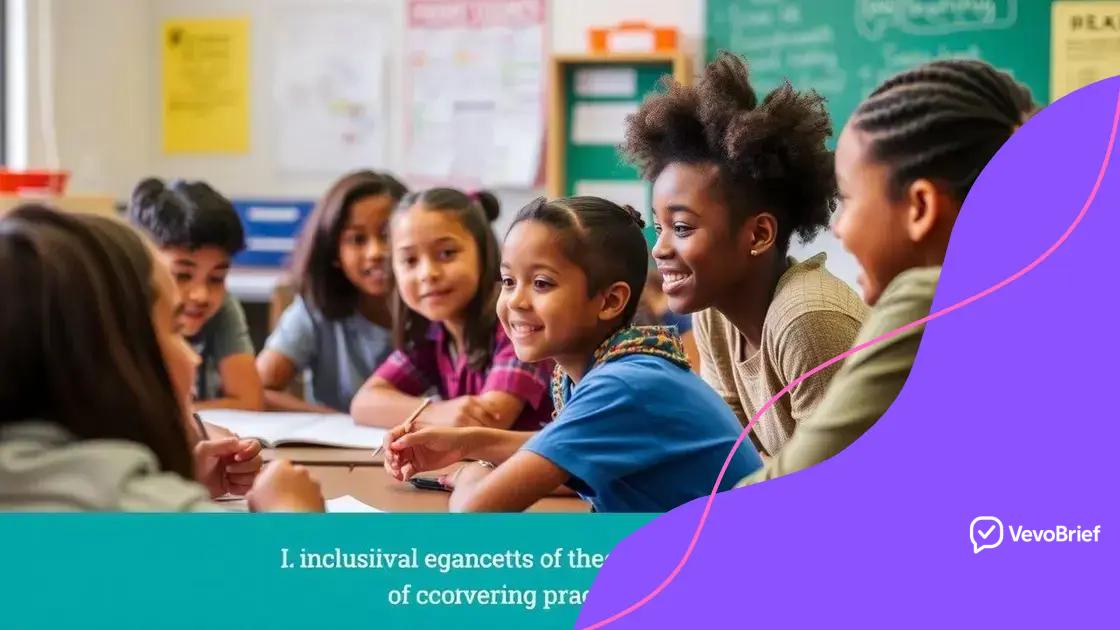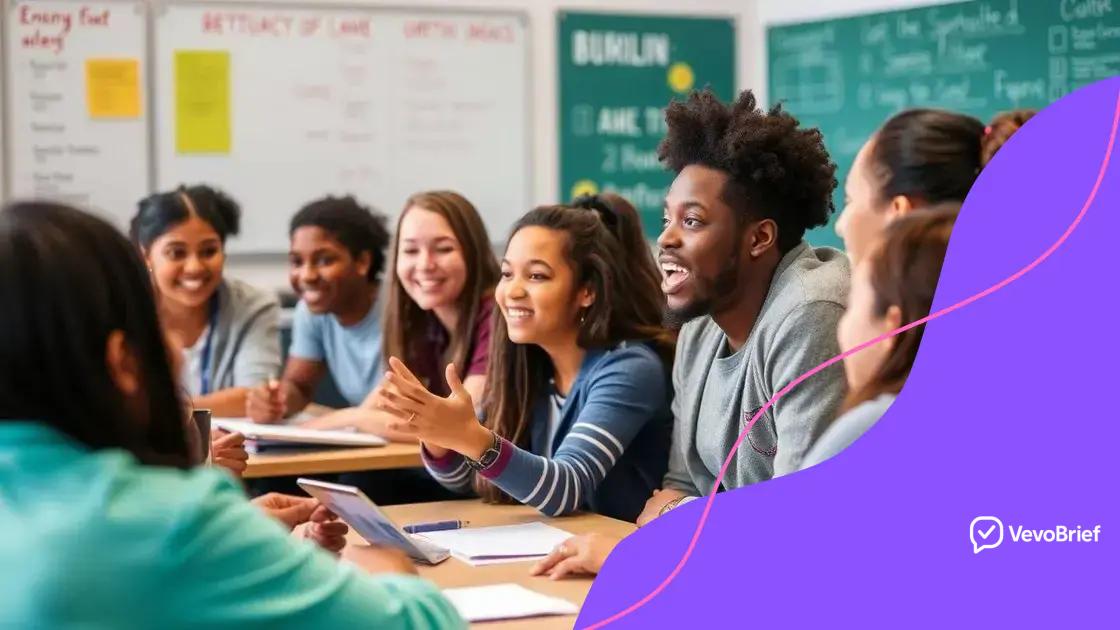Inclusive education policies’ impact on achievement

Inclusive education policies significantly impact student achievement by fostering supportive environments, encouraging participation, and addressing diverse learning needs through tailored strategies and collaborative practices.
Inclusive education policies’ impact on achievement is a topic that many educators and parents are passionate about. How can embracing diversity in classrooms help every child reach their potential? Let’s dive into this vital matter.
Understanding inclusive education policies
Understanding inclusive education policies is crucial for creating an environment where every student can thrive. These policies aim to provide equal access to education for children regardless of their backgrounds or abilities. In essence, they promote learning opportunities that cater to diverse needs.
When we look closer, we see how these policies work. They guide teachers and schools in fostering a classroom that embraces diversity. This means recognizing the unique strengths of each student and providing tailored support to help them succeed. Let’s explore the aspects that make up inclusive education policies.
Core Principles of Inclusive Education
The principles behind inclusive education policies focus on respect and value for every individual. Schools that embrace these principles tend to:
- Encourage participation from all students, no matter their abilities.
- Adapt teaching methods to meet various learning styles.
- Foster collaboration among students of different backgrounds.
These core principles serve to dismantle barriers that might hinder a student’s ability to learn. When students feel supported and valued, their chances of academic success significantly increase. On top of that, inclusive education fosters a sense of belonging.
Importance of Teacher Training
Another essential aspect is the training provided to educators. Teachers play a vital role in implementing inclusive education policies. Therefore, ongoing professional development equips them with strategies to address the needs of all learners. Training often involves:
- Techniques to create adaptable lesson plans.
- Methods for identifying specific learning challenges.
- Skills to promote positive relationships within the classroom.
Moreover, when teachers feel prepared and confident, they can create a more supportive classroom culture. This directly impacts student motivation and engagement.
In conclusion, understanding inclusive education policies is vital in planting the seeds for a better learning environment. By prioritizing inclusivity, schools can help every student reach their full potential.
The role of teachers in inclusive education
The role of teachers in inclusive education is essential for fostering a supportive learning environment. Teachers are the backbone of inclusive classrooms, guiding students from diverse backgrounds and abilities. With the right strategies, they can ensure that every child feels valued and included.
Teachers act as facilitators and advocates, adapting their teaching methods to meet the unique needs of each student. They assess individual learning styles and create lesson plans that enhance participation. By doing so, they ensure that lessons are accessible to everyone.
Effective Teaching Strategies
Some effective strategies that teachers use in inclusive education include:
- Differentiated instruction to tailor lessons for varying abilities.
- Collaborative learning activities that promote peer support.
- Use of assistive technology to aid learning.
These approaches help break down barriers for students who may struggle in traditional settings. It is essential for teachers to remain flexible and responsive to their students’ needs, ensuring that no one falls behind.
Building a Positive Classroom Culture
Moreover, teachers play a critical role in building a positive classroom culture. By establishing a sense of belonging, they encourage students to express themselves freely. Teachers can create an environment where every voice is heard by:
- Encouraging open discussions about diversity and inclusion.
- Promoting respect and empathy among classmates.
- Recognizing and celebrating individual differences.
When students feel comfortable and accepted, they are more likely to engage actively in their learning. This engagement leads to better academic outcomes and enhances social skills.
In summary, teachers are pivotal in making inclusive education successful. Their dedication to adapting teaching methods and fostering an inclusive atmosphere can greatly influence student achievement and well-being.
Impact on student engagement and motivation

Impact on student engagement and motivation is a crucial aspect of inclusive education. When students feel included, they are more likely to participate actively in their learning. This sense of belonging can significantly boost their motivation.
One important factor to consider is that inclusive education fosters a supportive environment. In such settings, students are encouraged to express their thoughts and ideas without fear of judgment. This encouragement leads to increased participation and deeper learning experiences.
Key Factors Influencing Engagement
Several factors contribute to student engagement in inclusive classrooms:
- Personalized learning that meets individual needs.
- Collaborative activities that create a sense of community.
- Positive reinforcement from teachers and peers.
By personalizing learning, educators can address the unique challenges each student faces. This individualized approach not only helps students feel understood but also enhances their motivation to succeed.
Benefits of Active Participation
Active participation benefits students in numerous ways. For instance, students who engage more in classroom activities tend to:
- Develop stronger social skills.
- Improve their academic performance.
- Build confidence in their abilities.
When students work together, they learn from each other and grow as a community. This collaboration is vital in creating a rich learning environment where all students feel supported.
Ultimately, the impact on student engagement and motivation in inclusive education cannot be overstated. By fostering an inclusive atmosphere, educators improve not only academic outcomes but also students’ overall well-being and happiness in school.
Assessing academic achievement in inclusive settings
Assessing academic achievement in inclusive settings is vital for understanding how effectively all students learn. In these environments, it is important to recognize the diverse ways students can demonstrate their knowledge and skills.
Teachers use various methods to assess students in inclusive classrooms. Traditional tests may not fully capture a student’s abilities, so alternative assessment strategies are often implemented.
Types of Assessments Used
Educators typically employ a mix of assessments to get a comprehensive view of student achievement. Common assessment types include:
- Formative assessments to monitor progress during the learning process.
- Summative assessments to evaluate learning at the end of a unit.
- Performance assessments that allow students to demonstrate skills in real-world tasks.
By utilizing these varied assessment types, educators can better support each student’s unique learning journey.
Benefits of Diverse Assessment Methods
Diverse assessment methods have many advantages. For one, they help to:
- Provide a fair evaluation of all students’ abilities.
- Identify areas where additional support may be needed.
- Encourage self-reflection and growth among students.
These benefits not only enhance learning but also improve students’ confidence by recognizing their strengths. When assessments match the individual needs of students, they are more likely to succeed.
Ultimately, assessing academic achievement in inclusive settings plays a crucial role in ensuring that all students receive the support they need to thrive academically and personally.
Challenges of implementing inclusive education
Challenges of implementing inclusive education are significant but essential to address for the success of all students. Despite the many benefits, schools often face obstacles that can hinder the inclusion process.
One major challenge is the lack of resources. Many schools struggle to provide the necessary materials, technology, and training needed for a truly inclusive environment. Without adequate resources, teachers may feel overwhelmed and unable to meet the diverse needs of their students.
Training and Professional Development
Another critical issue is insufficient training for educators. Many teachers may not have the proper training to handle a diverse classroom effectively. They need ongoing professional development to learn effective strategies for:
- Identifying different learning needs.
- Implementing effective teaching practices.
- Utilizing assistive technology.
When teachers are well-trained, they feel more confident in their abilities to support all students. This confidence can lead to a more inclusive and engaging classroom environment.
Attitudinal Barriers
Attitudinal barriers also play a significant role in the implementation of inclusive education. Sometimes, there are misconceptions about students with disabilities or those from different backgrounds. These misconceptions can lead to:
- Stereotyping and bias against certain students.
- Lower expectations from teachers and peers.
- Social isolation of students who need support.
To overcome these barriers, it is essential to foster a culture of respect and understanding within schools. Building awareness and promoting empathy can help to change attitudes and encourage inclusivity.
In summary, understanding the challenges of implementing inclusive education is key to developing effective solutions. Addressing these challenges ensures that all students have equal opportunities to learn and succeed.
FAQ – Frequently Asked Questions about Inclusive Education
What are the key benefits of inclusive education?
Inclusive education allows all students to learn together, promoting social skills, empathy, and a sense of community among diverse learners.
What challenges do schools face in implementing inclusive education?
Schools often face challenges like inadequate resources, lack of teacher training, and negative attitudes that can hinder the inclusion process.
How can teachers be trained to support inclusive classrooms?
Ongoing professional development can help teachers learn effective strategies for identifying diverse learning needs and implementing inclusive practices.
What role do students play in promoting inclusivity?
Students can foster inclusivity by embracing diversity, supporting their peers, and engaging in collaborative activities that enhance learning for everyone.
